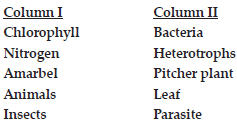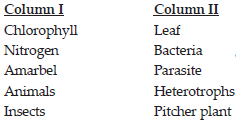Nutrition in Plants (Biology) Class 7 - NCERT Questions
Nutrition In Plants is the 1st chapter from NCERT Biology textbook for class 7. Here in this chapter, we will first start by discussing the introduction of the chapter, followed by the chapter end questions and answers.
In order to help students in the 7th grade to better understand the concepts, the NCERT Solutions for Class 7 Science Chapter 1 Nutrition in Plants are provided below. Expert teachers have generated the NCERT Solutions for Class 7 Science in accordance with the most recent CBSE Class 7 Science syllabus.
Students will get to solve questions like : a) Give a brief description of the process of synthesis of food in green plants. b) Where does the synthesis of food in a plant usually take place?
Regular practice is essential for students who want to succeed in their Class 7 exams. For students who want to do well on the upcoming Science board exam, practicing these NCERT Solutions is essential.
Why do organisms need to take food?
SOLUTION:Food is needed by all living organisms for their survival. It has the following roles :
(i) Food provides energy for growth and maintenance of the body parts.
(ii) Food provides essential nutrients (carbohydrates, vitamins, minerals, proteins, fats, roughage and water) required by the body to carry out various life processes.
(iii) Food is also needed by living beings for replacement and repair of their damaged and worn out cells.
(iv) Food gives us resistance against diseases and protects us from infections
Distinguish between a parasite and a saprotroph
SOLUTION: 
How would you test the presence of starch in leaves?
SOLUTION:Presence of starch in leaves can be tested by iodine test. Iodine solution turns starch blue-black. The leaf to be tested is put in a test tube containing ethyl alcohol. It is heated gently in a water bath until alcohol begins to boil. The colourless leaf is removed from alcohol and washed thoroughly with water. Then the leaf is placed in a petri dish and few drops of iodine solution are poured over it. If the leaf becomes blue-black after pouring few drops of iodine solution over it, then it indicates the presence of starch in it.
Give a brief description of the process of synthesis of food in green plants.
SOLUTION:The process of synthesis of food in green plants is referred to as photosynthesis, which mainly occurs in leaves. The leaves have a green pigment called chlorophyll. It helps leaves to capture the energy of the sunlight. This energy is used to synthesize food from carbon dioxide and water. Thus, chlorophyll, sunlight, carbon dioxide and water help to carry out the process of photosynthesis.
The solar energy captured by the leaves is stored in the plant in the form of chemical energy. Photosynthesis can be represented by the following equation :
![]()
Show with the help of a sketch that the plants are the ultimate source of food.
SOLUTION:The sketch to show that plants are the ultimate source of food is as follows :
![]()
Fill in the blanks:
(A) Green plants are called ___________ since they synthesize their own food.
(B) The food synthesized by the plants is stored as ___________.
(C) In photosynthesis solar energy is captured by the pigment called ___________.
(D) During photosynthesis plants take in ___________ and release ___________.
(A) autotrophs,
(B) starch,
(C) chlorophyll,
(D) carbon dioxide, oxygen.
Name the following:
(i) A parasitic plant with yellow, slender and tubular stem.
(ii) A plant that has both autotrophic and heterotrophic modes of nutrition.
(iii) The pores through which leaves exchange gases.
(i) Cuscuta (ii) Insectivorous plant (iii) Stomata
Tick the correct answer:
(A) Amarbel is an example of:
(i) autotroph (ii) parasite (iii) saprotroph (iv) host
(B) The plant which traps and feeds on insects is:
(i) Cuscuta (ii) china rose (iii) pitcher plant (iv) rose

B. 
Match the items given in Column I with those in Column II:


Mark ‘T’ if the statement is true and ‘F’ if it is false:
(i) Carbon dioxide is released during photosynthesis. (T/F)
(ii) Plants which synthesize their food themselves are called saprotrophs. (T/F)
(iii) The product of photosynthesis is not a protein. (T/F)
(iv) Solar energy is converted into chemical energy during photosynthesis
(i) F. Oxygen is released during photosynthesis.
(ii) F. Plants which synthesize their food themselves are called autotrophs.
(iii) T
(iv) T
Choose the correct option from the following:
Which part of the plant takes in carbon dioxide from the air for photosynthesis?
(i) Root hair (ii) Stomata (iii) Leaf veins (iv) Sepals
![]()
Choose the correct option from the following:
Plants take carbon dioxide from the atmosphere mainly through their:
(i) roots (ii) stem (iii) flowers (iv) leaves
![]()